Plan checklist
The Christopher Property
1073 The Narrows Road, Lake Of Bays
Planting plan created by The District Municipality of Muskoka
Funded by •


Schedule A:
Plants & Property
Land Characteristics
This planting plan is designed based on the land characteristics identified during the day of the site visit. Plants are chosen according to the soil and light conditions on your property. The number of plants chosen for each planting compartment takes into account the square metre area of the space, as well as the amount of current vegetation cover. Your property is part of ecoZone: 4b
Land Characteristics by Compartment
| Length | Width | Area | pH | Soil | Moisture | Light | Height | |
|---|---|---|---|---|---|---|---|---|
| A | 2.5m | 7.3m | 18.2m2 | acidic | sandy | dry | full sun, shade | |
| B | 11.7m | 2.6m | 30.4m2 | acidic | sandy, loamy | normal, moist | partial sun, shade | |
| C | 8.4m | 8.2m | 68.9m2 | acidic | sandy | normal | shade | |
| D | 7m | 5.8m | 40.6m2 | acidic | sandy | normal | shade | |
| E | 5.8m | 8.5m | 49.3m2 | acidic | sandy | normal | shade | |
| F | 7.9m | 6.5m | 51.4m2 | acidic | sandy | dry, normal | full sun, partial sun | |
| G | 3.9m | 8.5m | 33.1m2 | acidic | sandy | normal | full sun, partial sun | |
| H | 9.4m | 5.4m | 50.8m2 | acidic | sandy | dry, normal | full sun | |
| I | 2.9m | 5.5m | 8m2 | acidic | sandy | dry | full sun | |
| 59.5m | 6.48m | 350.7m2 |
Plant Selection Summary
The following shrubs and trees are chosen for their suitability and survivability given the current soil and light conditions in each compartment on your property, as well as preferable features.
| Plant Species | A | B | C | D | E | F | G | H | I | Potted | Bareroot | Wildflower |
|---|---|---|---|---|---|---|---|---|---|---|---|---|
| Ninebark | 2 | 1 | 1 | 4 | ||||||||
| Gray Dogwood | 2 | 1 | 1 | 4 | ||||||||
| Red Osier Dogwood | 3 | 2 | 3 | 1 | 2 | 11 | ||||||
| Black Spruce | 1 | 1 | ||||||||||
| Bearberry | 3 | 3 | ||||||||||
| Ostrich Fern | 3 | 12 | 9 | 6 | 30 | |||||||
| Bracken Fern | 9 | 9 | ||||||||||
| Steeplebush | 2 | 2 | ||||||||||
| Buttonbush | 1 | 1 | 1 | 3 | ||||||||
| Nannyberry | 1 | 1 | ||||||||||
| Sweet Gale | 2 | 2 | 1 | 5 | ||||||||
| Narrow Leaved Meadowsweet | 1 | 6 | 3 | 10 | ||||||||
| Shining Willow | 1 | 1 | ||||||||||
| Royal Fern | 4 | 4 | ||||||||||
| Blue Flag Iris | 3 | 3 | ||||||||||
| Blue Vervain | 3 | 3 | ||||||||||
| Yellow Birch | 1 | 1 | ||||||||||
| Hobblebush | 3 | 3 | ||||||||||
| Mountain Maple | 3 | 3 | ||||||||||
| Eastern Hemlock | 1 | 1 | ||||||||||
| Bush Honeysuckle | 3 | 3 | 3 | 6 | 3 | 18 | ||||||
| Christmas Fern | 9 | 6 | 15 | |||||||||
| Silver Maple | 1 | 1 | ||||||||||
| Lowbush Blueberry | 2 | 2 | ||||||||||
| White Pine | 1 | 1 | ||||||||||
| Common Polypody | 3 | 3 | ||||||||||
| Wild Columbine | 6 | 6 | ||||||||||
| Canadian Serviceberry | 1 | 1 | 2 | |||||||||
| Kalm St. Johns Wort | 3 | 3 | 6 | 12 | ||||||||
| Alternate-Leaved Dogwood | 1 | 1 | 1 | 3 | ||||||||
| Canadian Wild Ginger | 12 | 12 | ||||||||||
| Bunchberry | 6 | 6 | ||||||||||
| Sensitive Fern | 3 | 3 | 6 | |||||||||
| Fragrant Sumac | 3 | 3 | ||||||||||
| Sweet Oxeye | 3 | 3 | ||||||||||
| Sweet Fern | 3 | 3 | ||||||||||
| Shrubby St. John's wort | 1 | 1 | ||||||||||
| Butterfly Milkweed | 3 | 3 | 6 | |||||||||
| Smooth Wild Rose | 3 | 3 | ||||||||||
| Wild Bergamot | 5 | 5 | ||||||||||
| Dense Blazing Star | 5 | 5 | ||||||||||
| Purple Coneflower | 8 | 8 | ||||||||||
| Big bluestem or Turkey foot | 3 | 3 | ||||||||||
| Oswego Tea (Red Bergamot) | 6 | 6 | ||||||||||
| Black-Eyed Susan | 5 | 5 | ||||||||||
| Subtotal | 20 | 18 | 44 | 18 | 34 | 29 | 19 | 14 | 44 | 99 | 0 | 141 |
| Totals | 240 | |||||||||||
Plant Information
The following table summarizes key information about each plant selected for your property.
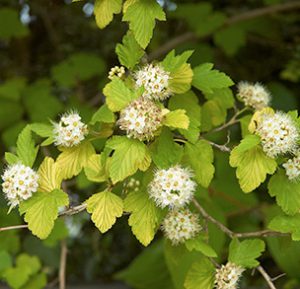
|
NinebarkHeight: 2-3m
The Common Ninebark is a very hardy, large (2-3m in height), deciduous shrub naturally occurring within riparian zones. This species is often planted as an ornamental shrub for its exfoliating bark which reveals reddish-light brown inner bark. This shrub is multi-stemmed with numerous horizontal and ascending branches creating a full, round shape. The Common Ninebark produces dull green, ovate to round shaped leaves with three to five lobes per leaf. During the fall the leaves turn brilliant yellow or dark purple. Between May and June, showy, bell-shaped flowers bloom in clusters on the terminal ends of the branches. During the summer, these flowers give way to small green or green-yellow berries which turn a bright red upon ripening.
|
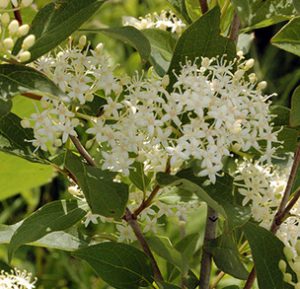
|
Gray DogwoodHeight: 2-3m
The Gray Dogwood, also referred to as Northern Swamp Dogwood or Panicle Dogwood, is a medium-sized, deciduous shrub which typically grows 2-3m. This species is multi-stemmed, with a full, round form. The leaves are green and arranged alternately along the branches. During the fall, leaves turn a bright red to deep purple colour. Between May and June, showy clusters of small white flowers bloom. These flowers turn into white fleshy berries late in the summer. The reddish-pink stems hold the berries throughout the winter, creating an artful contrast to the gray bark and snowy scenery. The Gray Dogwood is tolerant of a variety of environmental conditions and its complex, fibrous root system make it an ideal plant to use for controlling erosion.
|
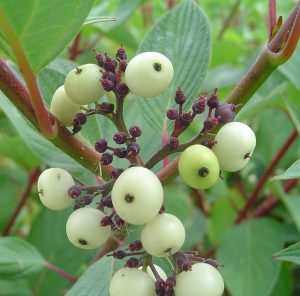
|
Red Osier DogwoodHeight: 1.5-4m
The Red Osier Dogwood is a medium-sized, deciduous shrub native throughout Northern and Western North America which typically grows to 1.5-4m. This species is multi-stemmed with numerous erect and ascending bright red branches that create a loose and spreading form. Leaves produced are simple, two-toned with a dark green upper side and light green underside. They are arranged opposite each other along the branches. During the fall, the foliage turns a brilliant red to dark purple. Clusters of small, creamy white flowers form on the terminal ends of the branches between June and July. The Red Osier Dogwood produces blueish-white fruiting bodies during late summer, which may persist throughout the winter. This shrub's berries provide an important winter food source for numerous species, from large deer to small wintering birds.
|
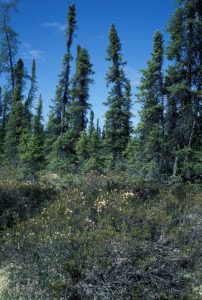
|
Black SpruceHeight: 20-30 m
The Black Spruce varies in size depending on soil conditions. On poorly drained sites, the trees are typically grow smaller and slower, up to 20m high and 30cm in trunk diameter. However, on well-drained upland sites, these trees can grow up to 30 m high and 60 cm in trunk diameter. The branches of the Black Spruce are comparatively shorter than other spruce species, and lower branches can appear extremely weighted and droopy. The crown of the tree is often very dense, and oddly shaped with many cones. The needles are short, single, and straight with blunt points, ranging from 8-15 mm in length. They are a dull grayish-green colour with lines of white spots on the under surface of the needle. Seed cones are broadly ovoid and egg shaped, 2-3 cm in length, and have a dark purplish-brown colour. The scales are brittle and tight fitting with an irregularly toothed margin. The cones mature around September and can remain on the tree for up to 30 years, gradually releasing seeds in normal conditions, while quickly releasing seeds following traumatic events, like forest fires. Open cones are almost spherical, brittle and toothed. The bark is reddish or grayish brown in colour when young, becoming darker, and boasting more prominent scales with age.
|
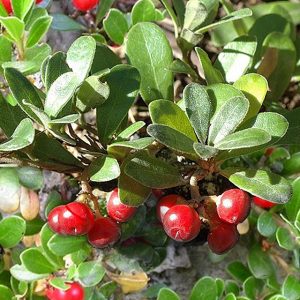
|
BearberryHeight: 20 cm
Bearberry is a low growing, evergreen shrub/ground cover species that grows about 20 cm tall. The leaves are dark green, leathery, shiny, ovate shaped, alternately arranged, and have entire margins. The flowers are tiny, urn shaped, white to pink colored, appear in drooping clusters, and bloom between April and May. Flowers are followed by bright red berries, which remain throughout the fall and winter. These berries are beneficial to wildlife species like birds and small mammals.
|
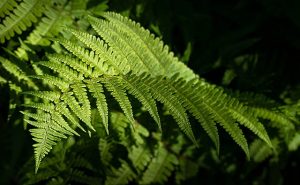
|
Ostrich FernHeight: 1.5 m
The Ostrich Fern is a coarse, erect to arching perennial fern, that can grow up to 1.5 m in height. The stems are clustered and arching while the leaves are ostrich-plume shaped, widest near top, and very gradually narrowed to the base. The size of the leaves grow up to 1.5 m long and 12-40 cm wide, with around 40 pairs of leaflets or pinnae. The leaflets are long, narrow-pointed, and ascending. The leaves are fertile, with spore clusters on the undersides of sub-leaflets.
|
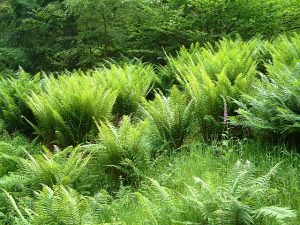
|
Bracken FernHeight: 1 m
The Bracken Fern is a large, hardy fern species that can grow up to 1 m in height. The leaves are large, triangular fronds, which are pinnately divided 2-3 times and have spores along the edge of leaves. The leaves emerge as fiddleheads between March and May. The fiddleheads can be edible for humans but may contain toxic, carcinogenic properties so should be carefully researched and prepared before consumption. This plant can grow aggressively and should be planted with lot's of space. Fossils of Bracken Fern have been found that are over 55 million years old.
|
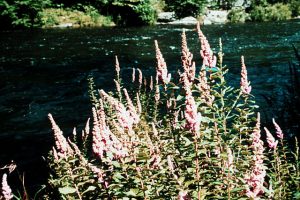
|
SteeplebushHeight: 1 m
The Steeplebush is a deciduous shrub species that typically grows about 1 m in height . This plant may also be known by the common names: Rose Spiraea or Hardhack. The leaves are dark green, about 7 cm long, elliptic to ovate shaped, have toothed margins, and have dense yellowish brown hairs on the undersides. The flowers are tiny, rose pink to purplish coloured, bloom in late summer, and appear on tall, dense, steeple shaped clusters. This plant is useful for controlling erosion and stabilizing shorelines. The flowers are also beneficial for pollinator species, like bees and butterflies.
|
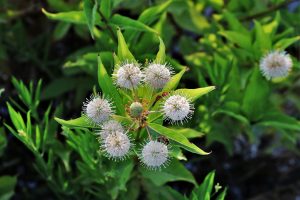
|
ButtonbushHeight: 2 m
Buttonbush is a small to medium-sized deciduous shrub species which typically grows about 2 m in height. This plant may also be known by the common name Button Willow. Twigs are slender to stout and dark red-brown in colour with white speckling. The leaves are bright green coloured, shiny, ovate shaped, oppositely arranged, and have entire margins. The flowers are tiny, tubular, white, fragrant, and appear densely on distinctive, spherical clusters in June. These flowers turn into a dense cluster of seeds, which remain on the plant throughout the winter. The flowers are beneficial for pollinator species, including hummingbirds and butterflies. This is a hardy, adaptable species and an excellent choice for planting on wet shoreline sites.
|
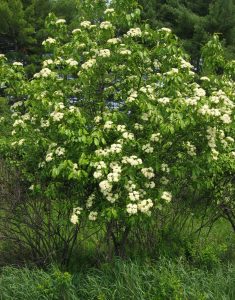
|
NannyberryHeight: 3 m
Nannyberry is a large deciduous shrub species that typically grows about 3 m in height. The leaves are dark green, ovate shaped, oppositely arranged, have a pointed tip, and have finely toothed margins. The flowers are showy, white colored, appear in flat topped clusters, and bloom in May. These flowers produce blueish black berries, which are edible to humans and persist throughout the winter. The flowers are beneficial to pollinator species , like bees and butteries. The fruit is beneficial to wildlife species, including birds and small mammals. This shrub has attractive fall foliage. The root system is extensive, making this plant valuable for controlling erosion and stabilizing loose soil. This shrub can be pruned to have a single stem and grown as a small tree instead of a shrub.
|
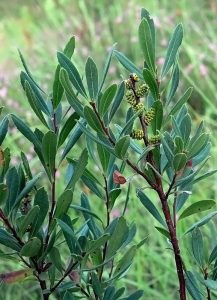
|
Sweet GaleHeight: 1-2m
Sweet Gale is a medium-sized shrub which grows into a thick bush about 1-2 m tall. This species produces 1-8 cm long, oblong-lanceolate leaves which are finely toothed at the tip and are spirally arranged. When bruised, these leaves give off a pleasant aroma. Male and female catkins are produced on separate plants. The seeds are dispersed from the female plants via water, as they float on two corky bracts. This shrub also provides a good food source for bird species that eat the seeds including Grouse, Chickadees, and Bluebirds. Mammal species like Beavers and White-Tailed Deer also browse on the twigs and leaves of this plant.
|
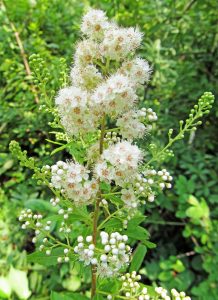
|
Narrow Leaved MeadowsweetHeight: 1-2m
The Narrow Leaved Meadowsweet is an erect, deciduous shrub, which grows in the shape of a mound to a height of 1-2m. This species develops numerous branches and branchlets, giving it a sparse appearance. Leaves produced are simple and narrow with sharply toothed borders growing alternately along the branches. These bright, light green leaves appear crowded, as they grow close together on the stocks and branches. During the fall, leaves turn a yellow-red or yellow-orange colour. Small white to light pink flower clusters appear in the spring growing in a dense, narrow pyramid at the terminal ends of the branches. During late summer to early fall, these flowers produce smooth, papery seed pods.
|
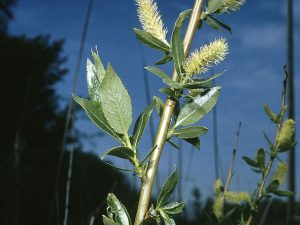
|
Shining WillowHeight: 10m
The Shining Willow is a relatively large deciduous shrub, which grows up to 10 m in height. The shiny leaves are 5-11 cm long and 1-5 cm wide, which are what give this Willow its name. They are lance shaped, with dark green color on the top, and light green on the bottom. Flowers bloom from May to June and range in colour from yellow to a green/brown.
|
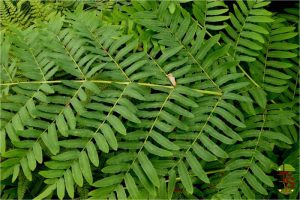
|
Royal FernHeight: 1 m
Royal Fern is a perennial fern species that typically grows less than 1 m in height. This plant may also be known by the common name Flowering Fern. Fiddleheads appear from the base of the plant and unfurl into green, arching, pinnately compound leaves. The leaves of this fern are well separated, broader, and more rounded than other ferns, giving it the appearance of a pea plant. Erect, spore-bearing fronds grow out of the center of the leaves in the early spring and turn brown in the fall. The fronds of this fern have a flower like appearance.
|
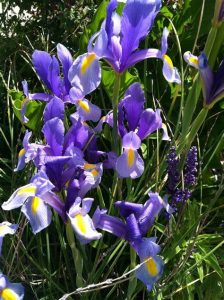
|
Blue Flag IrisHeight: 0.5 m
The Blue Flag Iris is a showy perennial wildflower that typically grows about 0.5 m in height. This plant may also be known by the common name Harlequin Blue Flag. The leaves are light green, sword-shaped, slightly arched or erect, and appear growing out as a cluster around the base of the plant. The attractive blue flowers start to bloom in the early spring, emerging from a tall flowering stalk that can reach up to 1 m. The flowers are beneficial to pollinator species, like bees and butterflies. The seeds are also beneficial to wildlife species, like birds and small mammals.
|
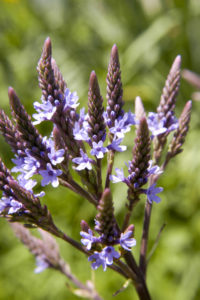
|
Blue VervainHeight: 1.5 m
Blue Vervain is a perennial wildflower species that grows about 1.5 m in height. It has a slender, upright form with reddish-green coloured, rough-haired stems. Its leaves are oppositely arranged, lance-shaped, and on short petioles with large serrations along the edge. Occasionally, there are two lobes present at the base of the leaves. The flowers are showy, blueish purple coloured, have five petals, appear on dense spikes at the top of flowering stems, and bloom between July and September. The flowers bloom first at the bottom of the spike, travelling upwards and blooming in bands. This plant spreads well and can form small colonies. The flowers are beneficial to pollinator species, like bees and butterflies. The seeds are also beneficial to wildlife species, like birds and small mammals.
|
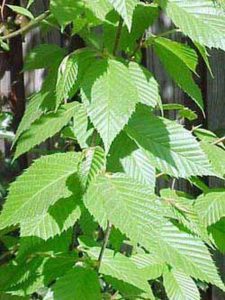
|
Yellow BirchHeight: 25 m
Yellow Birch is a native deciduous tree species that can grow up to 25 m in height. The bark is thin, flaky, shiny, and can be brownish-yellow, bronze, or silvery colored. The leaves are deep greenish-yellow, simple, alternately arranged, oval shaped, have doubly serrated edges, and are about 8-11 cm long. This tree species produces catkins in April-May, which are slim, cylinder shaped, yellowish brown flower clusters. In the Fall, seed pods are produced that are brown colored, cone shaped, and break apart easily. Yellow Birch is a slow growing tree but can live up to 150 years. This tree species is beneficial to wildlife species like birds and mammals.
|
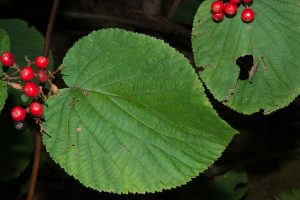
|
HobblebushHeight: 3 m
Hobblebush is a shrub species that typically grows about 3 m in height. The leaves are large, oppositely arranged, medium green coloured, ovate shaped with cordate bases, have prominent veins giving a wrinkly appearance, have finely serrated margins. The flowers are showy, white coloured, fragrant, appear in flat-topped clusters, and bloom between May and June. This plant has distinctively different inner fertile flowers and outer sterile flowers. The fruit are small, edible, oval shaped berries that change from pale green to red to purplish black coloured when ripe. This shrub produces attractive fall colours changing from bronze red to purple. The flowers are beneficial to pollinator species, like bees and butterflies. The fruits are also beneficial to wildlife species, like birds and small mammals. The branches may bend and take root in the ground, which can trip or hobble people passing by, hence the common name. This plant is easy to grow and easy to transplant.
|
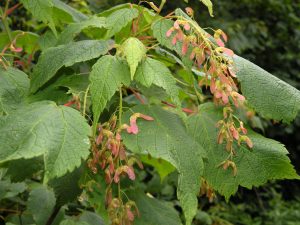
|
Mountain MapleHeight: 3-5m
The Mountain Maple is a mid-sized shrub and the smallest Maple species, ranging from 3-5 m tall. The leaves are a triangular shape with 3-5 lobes each and range from 6-12 cm long and wide in size. The upper side of the leaf is a yellowish green with a pubescent white underside. The leaves also have coarsely and irregularly toothed margins and the leaf petioles are red in colour. The flowers are small, pale yellow to green in colour, and form in dense upright clusters. Both male and female flowers may be found within the same cluster. Vibrant red fruit grows with wings that are about 2-3 cm long. This shrub is very important for riparian edges as it is great for preventing erosion on stream banks and steep slopes using its dense layered root system.
|
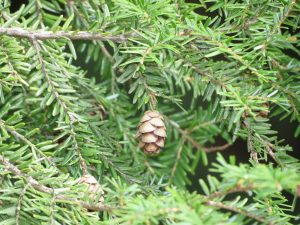
|
Eastern HemlockHeight: 30m
The Eastern Hemlock, or Canadian Hemlock, is a medium-large sized conifer tree reaching 30m in height, which has a conical shape and a tapered trunk. This species produces slender branches that grow horizontally from the trunk with heavy foliage and a drooping terminal end. The Eastern Hemlock produces flat needles that are two-ranked, with shorter needles on the upper side of the branch. This species produces small, oval-shaped cones approximately 2 cm long, which are initially green in colour and turn brown in the fall. The Eastern Hemlock is known to have the smallest needles and cones of its genus. This species has shallow and wide spreading roots, which make it an ideal tree species to plant for controlling erosion on dry slopes.
|
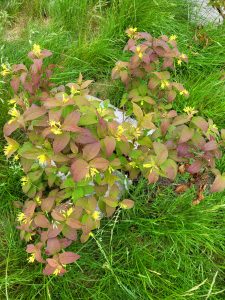
|
Bush HoneysuckleHeight: 1m
The Bush Honeysuckle is a small, hardy, deciduous shrub that rarely grows taller than 1 m in height. The leaves are simple, oppositely arranged, ovate shaped, and have finely toothed margins. During the spring and summer, the leaves are dark green in colour, then in the fall they take on a variety of colours ranging from a deep purple to light yellow. The flowers are small, showy, yellow to orange colored, trumpet shaped, appear in clusters on the tips of branches, and bloom between June and July. The flowers are beneficial to pollinator species, including hummingbirds and butterflies. The roots of the Bush Honeysuckle are fibrous, giving it the ability to form thickets and making it an ideal shrub to plant for erosion control.
|
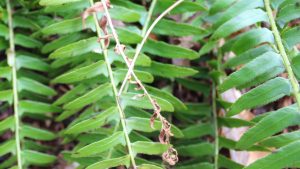
|
Christmas FernHeight: 0.5 m
The Christmas Fern is a hardy evergreen fern which can withstand a variety of environmental conditions. It is one of the most common ferns within North America. This species produces robust, leathery, lace-like leaves which grow in a fountain like clump and persist throughout the winter. Silvery and scaled fiddleheads emerge early in the spring. This fern rarely exceeds heights of half a meter and is a popular fern species to utilize in landscaping due to its year-round colour. This fern is often planted for restoration applications due to its ability to conserve soil and control erosion.
|
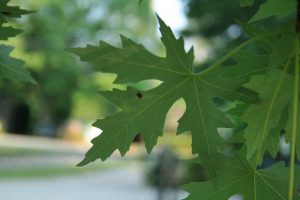
|
Silver MapleHeight: 30m
The Silver Maple is a fast growing, deciduous Maple tree famous for its majestic, mature form. This species has a broad, round crown that sits on top of a tall straight trunk reaching 30m in height. Its ascending branches give this tree a full, bushy appearance. Silver Maple leaves can be differentiated from other Maple leaves due to the deep notches on their lobes. It has a silvery white colour on its underside in contrast to bright, light green topside. During the fall, the leaves on the Silver Maple turn a reddish orange to bright golden yellow. Between late April and May, inconspicuous, small greenish red flowers bloom and by June turn to yellowish-green or brownish pairs of winged keys. The Silver Maple's shallow, spreading root system and ability to withstand flood and drought make it an excellent tree to utilize for erosion control and shoreline stabilization.
|
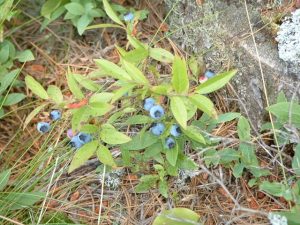
|
Lowbush BlueberryHeight: 60 cm
The Lowbush Blueberry is a low growing, deciduous shrub that only reaches about 60 cm in height. This species grows erect, with many spreading and ascending branches. New branch growth is soft and green-brown in colour, while older branches are woody and have shredded looking bark. The leaves are small, simple leaves alternately arranged, and have finely serrated margins. During the fall, this shrub's lustrous blue-green leaves turn into an electrifying bronze, scarlet or crimson colour. Clusters of small, white, bell-shaped flowers bloom between May and June. By July, the flowers give way to clusters of edible blueberries. These berries provide a significant food source for a variety of bird and mammal species.
|
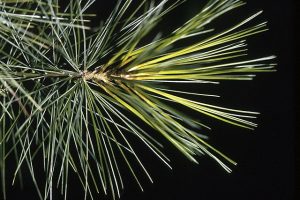
|
White PineHeight: 30m
The White Pine is Ontario's provincial tree. This species is the largest northeastern conifer with soft and light needles, which typically grows 30m in height. The needles are bundled into groups of 5 and are spirally spread around the twigs. White Pine bark is smooth and grey-green when young, becoming dark grey and deeply furrowed upon maturation. This tree produces yellow-green seed cones which are long, cylindrical, and covered in 50-80 scales. Unfortunately, this species is susceptible to White Pine Blister Rust and attacks by the White Pine Weevil. White Pine is a hardy tree which can tolerate a wide range of soil conditions, from sphagnum bogs to dry sandy and rocky ridges.
|
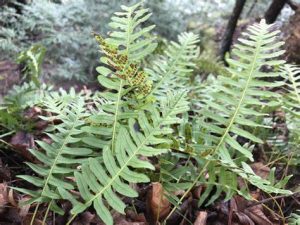
|
Common PolypodyHeight: 30 cm
The Common Polypody is a small, evergreen fern species that typically grows less than 30 cm in height. This plant may also be known by the common names Rock Polypody or Rock Cap Fern. The leaves are erect, leathery, yellow green to dark green colored, and pinnately compound with 8-20 deep lobes.
|
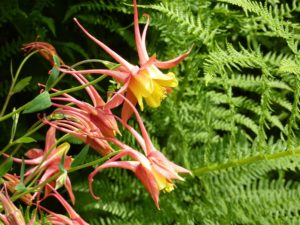
|
Wild ColumbineHeight: 0.5 m
Wild Columbine is a perennial wildflower that grows about 0.5 m tall and is popular among gardeners due to its beautiful red and yellow coloured flowers. These flowers are nodding flowers, meaning that they droop downwards off the end of the branch. They have five sepals and five petals that stretch upwards creating five long spurs out the back. The leaves are attractive, compound and made up of 9-27 leaflets, appear in groups of three, and are rounded or broadly egg-shaped with rounded lobes. The sweet nectar of this wildflower is a great attractant to hummingbirds and butterflies.
|
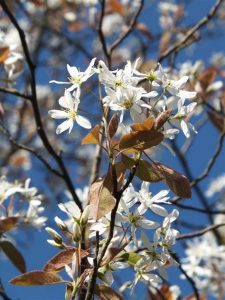
|
Canadian ServiceberryHeight: 3-5 m
The Canadian Serviceberry is a multi-stemmed shrub or small tree which grows from 3-5 m in a dense round form. This plant may also be known by the common names: Juneberry, Shadblow, or Shadbush. Early in the spring, prior to leaf development, clusters of fragrant, showy white flowers bloom along the branches. By July, these flowers give way to the fruiting bodies. The fruits are initially small, green berries, which grow to the size of blueberries and turn a deep purple-blue upon maturation during the fall. Leaves produced are finely toothed and spear-shaped. Throughout the summer, leaves are dark green and turn a dramatic orange-red during the fall.
|
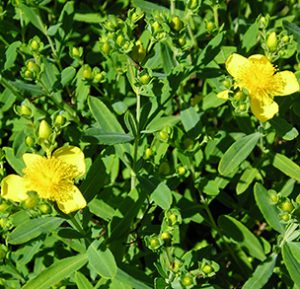
|
Kalm St. Johns WortHeight: 1 m
Kalm St. Johns Wort is a short, evergreen shrub species that typically grows less than 1 m in height. Older bark is reddish brown and appears shedding. The leaves are bluish green colored, narrow and linear shaped, appear in oppositely arranged pairs, and have entire margins. The flowers are showy, golden yellow colored, have five petals, numerous stamens, appear on upper branching stems, and bloom between July and August. These flowers produce small brown oval seed capsules. The flowers are beneficial for pollinator species, like bees and butterflies. These shrubs are visually attractive and used for making low hedges.
|
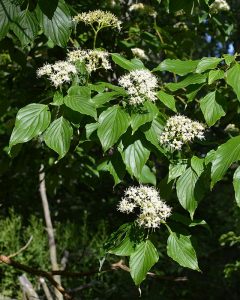
|
Alternate-Leaved DogwoodHeight: 5-10 m
The Alternate-Leaved Dogwood is a tall, deciduous shrub or small tree species that can grow 5-10 m in height. This plant may also be known by the common name Pagoda Dogwood. It can be grown either in the form of a single stem tree or multi-stemmed shrub comprised of two or three smaller trunks. The leaves are ovate shaped, alternately arranged, have prominent veins, have a pointed tip, and have entire margins. The flowers are showy, fragrant, whitish yellow, appear in flat clusters, and bloom between May and June. These flowers produce clusters of dark blue berries. The flowers are beneficial for pollinator species while the berries are beneficial for wildlife species. The root system is valuable for controlling erosion and stabilizing loose soil. This plant is often used as a small ornamental tree in landscaping. The common name comes from the fact that all other Dogwood species have oppositely arranged leaves.
|
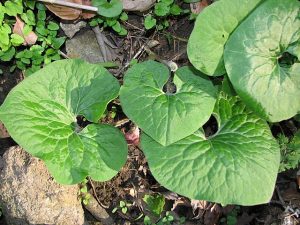
|
Canadian Wild GingerHeight: 10-20 cm
Canadian Wild Ginger is a perennial ground cover species that typically grows between 10 and 20 cm in height. The leaves are large, velvety, heart shaped with a deep cleft at the base, have entire margins, are covered with soft hairs, and appear in pairs. The single flower is reddish or purplish brown, cup shaped, not showy, appears between the two leaf stalks, and blooms in the early Spring between April and June. The roots have a strong ginger flavor and spread to produce small colonies. It is useful for controlling erosion and stabilizing shorelines.
|
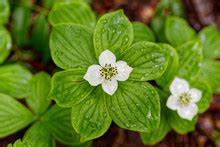
|
BunchberryHeight: 15 cm
Bunchberry is a deciduous ground cover species that can grow around 15 cm in height. This plant may also be known by the common name Creeping-Dogwood. The leaves are deep green, oppositely arranged, oval shaped, and glossy. The flowers are showy, white colored, and bloom between May and June. These flowers produce bright red berries that are edible to humans and beneficial to wildlife species, like birds and small mammals.
|
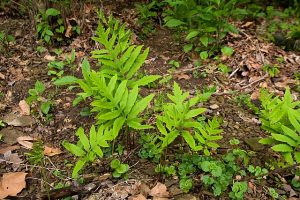
|
Sensitive FernHeight: 1 m
Sensitive Fern is a perennial fern species that typically grows less than 1 m in height. The leaves of this fern are light green, narrow, spaced out, have descending lower leaflets, and ascending upper leaflets. Erect, spore-bearing fronds appear out of the center of the leaves in the early spring and turn brown in the late summer. The fronds of this fern have a woody, segmented bead appearance.
|
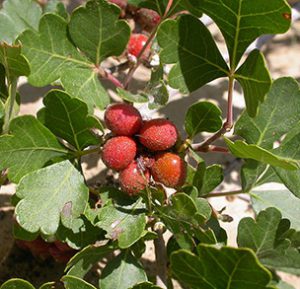
|
Fragrant SumacHeight: 1-2m
The Fragrant Sumac is a medium-sized deciduous shrub within the Cashew family. This species grows between 1-2 meters in height, is multi-stemmed, and produces a round, dense crown composed of erect and spreading branches. Between March and April, small yellow flower clusters bloom on the terminal ends of the branches prior to leaf development. Fruit development begins during late summer. Small, red, hairy berries are produced and can remain on the plant throughout the winter. Male catkins develop on the plant in September. Fragrant Sumac leaves are simple and arranged alternately along the branch. Leaves produced are simple and trifoliate with a large center lobe, appearing similar to Poison Ivy. During the spring and summer, the leaves are light green to green-yellow in colour turning a bright yellow to red or dark purple in autumn. Crushed leaves and stems of the Fragrant Sumac produce a fragrant citrus aroma, hence the common name. The aroma of this shrub is attractive to butterfly species, making it the perfect addition to any butterfly garden. The roots of the Fragrant Sumac are shallow, fibrous, and spread rapidly, making it an ideal choice for stabilizing shorelines and mitigating erosion on steep slopes. Unlike other Sumac species, Fragrant Sumac is significantly less aggressive and easily maintained.
|
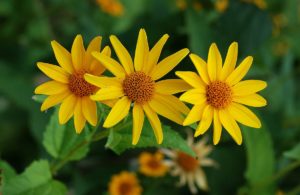
|
Sweet OxeyeHeight: 2m
Sweet Oxeye, also known as False Sunflower, is an attractive, herbaceous, perennial wildflower, which can grow to almost 2 m tall. The flowers are perched atop a stiff stem, with a brownish-yellow center cone surrounded by bright yellow to orange rays. Leaves are 5-12 cm long and 2-8 cm wide, oppositely arranged along the stem, ovate to lanceolate in shape, and have a toothed margin. This wildflower grows best in moist, well-drained soils, preferring full sun, but will tolerate partial shade. Some common natural habitats for the Sweet Oxeye are prairies, meadows, forest edges, and stream banks. Sweet Oxeye is drought tolerant so could be planted in difficult dry sites, but will grow best with regular watering. A large variety of insect species are attracted to the Sweet Oxeye, making it a great addition to a habitat garden.
|
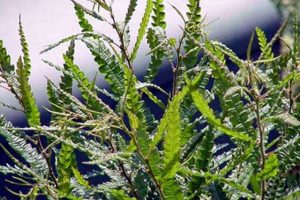
|
Sweet FernHeight: 1 m
Sweet Fern is a deciduous shrub species that typically grows 1 m in height. The leaves are dark green coloured, alternately arranged, narrow, lance shaped, have entire margins, rounded lobes, and are deeply notched, giving the appearance of a fern. The leaves are also aromatic when rubbed or crushed. The flowers are small, yellowish green catkins, which bloom between May and June. The fruits are greenish brown, burr like nutlets. This plant fixes it’s own nitrogen, which allows it to grow in poor soil and benefit nearby plants. This plant spreads well to produce small colonies. It is useful for controlling erosion and stabilizing shorelines.
|
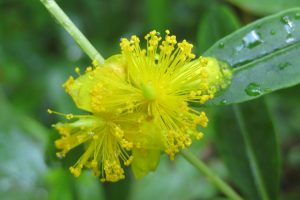
|
Shrubby St. John's wortHeight: 1 m
The Shrubby St. John's Wort is a small 1m tall, round, deciduous shrub which grows stiff, erect branches with red to purple bark. Leaves produced are blue-green, simple, elliptical-shaped, 3-7 cm long and oppositely arranged along the branch. During the fall, the leaves turn a deep red colour. This species yields large bright yellow flowers which grow in clusters of at the terminal end of branches during late June to August. By September, the flowers become brown seed pods and release small black seeds throughout October. Shrubby St. John's Wort produces fibrous, spreading roots, making it an ideal species for bank stabilization applications.
|
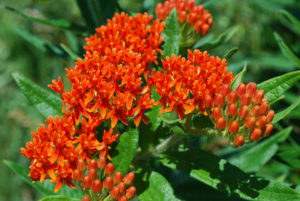
|
Butterfly MilkweedHeight: 0.5 m
Butterfly Milkweed is a very attractive perennial wildflower that typically grows about 0.5 m tall. This plant may also be known by the common name Showy Milkweed. The leaves are green coloured, alternately arranged, narrow and lance-shaped, and have entire margins. The flowers are showy, fragrant, bright orange coloured, have five tiny petals, appear in clusters of 8-25, and bloom between June and August. Butterfly Milkweed is easy to grow and is low maintenance. This wildflower spreads well and can be used to naturalize un-vegetated areas. The roots can be useful for controlling erosion and stabilizing shorelines. The flowers are beneficial to pollinator species, like bees and butterflies. It is also a larval host for caterpillars of the endangered Monarch Butterfly, thus planting this species where possible can help protect this at risk species.
|
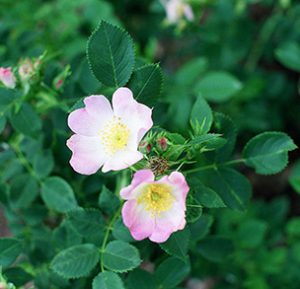
|
Smooth Wild RoseHeight: 1.5m
The Smooth Wild Rose is a shrub species that grows about 1.5 m tall. The name is derived from the fact that it is almost thornless with only a few sharp thorns present near its base. This native shrub is best known for producing beautiful pale pink flowers with five saucer-like petals surrounding a yellow center. The Smooth Wild Rose produces bright red rose hip fruiting bodies which develop during the summer and persist throughout the winter. Leaves produced are alternate and compound, consisting of 5-7 serrated, egg-shaped leaflets.
|
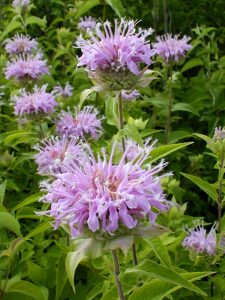
|
Wild BergamotHeight: 1 m
Wild Bergamot is a perennial wildflower species that is member of the mint family and can grow about 1 m tall. Its stems are light green and smooth with abundant branching on the upper half. The leaves are oppositely arranged, broadly lanceolate shaped, 6-10 cm long, and have toothed edges. The also leaves emit a aromatic minty/oregano scent when crushed. The flowers are showy, pink/lavender coloured, appear on the ends of flowering stems, and bloom between July and September. The flowers bloom in the center of the head first, moving outwards creating a wreath. The flowers are beneficial to pollinator species, like bees and butterflies. This wildflower spreads well and can be used to naturalize un-vegetated areas. The roots can be useful for controlling erosion and stabilizing shorelines.
|
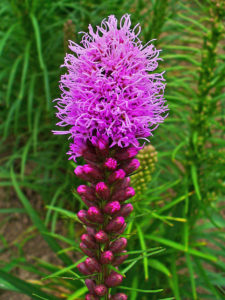
|
Dense Blazing StarHeight: 30-60 cm
Dense Blazing Star is a tall clump-forming perennial wildflower species that can grow between 30 and 60 cm. It has an erect central stem (no branching) that is smooth and purplish/green with many grass-like leaves circulating alternately around it. The leaves are long, narrow, and hairy with one noticeable central vein. This plant is very noticeable when in bloom as it has a wand-like spike of purplish/pink flowers at the top of the central stem. The flowers consist of 4-10 disk florets with a tubular corolla that opens up to 5 spreading star-like lobes and a deeply split protruding style. It prefers moist, well-drained areas such as meadows, moist fields, and along river of lake shorelines. It attracts lots of butterflies and pollinators, as well as mammals such as deer and rabbits. Unfortunately, Dense Blazing Star is listed as threatened under SARA in Ontario. It's main threat is habitat loss due to urban development and habitat alteration. It only naturally occurs in southwestern Ontario with 11-13 known populations. Therefore, this is a great species to plant in suitable areas in Ontario to help protect a threatened species.
|
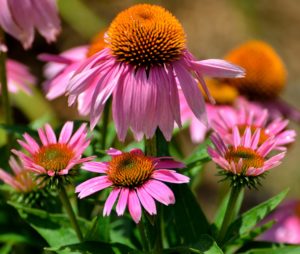
|
Purple ConeflowerHeight: 1m
Purple Coneflower is a perennial wildflower that typically grows about 1 m tall. This plant may also be known by the common name Echinacea. The leaves are dark green coloured, alternately arranged, lance shaped with pointed tips, and have serrated margins. The flowers are showy, pale purple to pink, have 15-20 toothed petals, appear atop erect stems, and bloom between June and August. This wildflower spreads well and can be used to naturalize un-vegetated areas. The roots can be useful for controlling erosion and stabilizing shorelines. This flower blooms for long periods. The flowers are beneficial to pollinator species, like bees and butterflies. The seeds are also beneficial to wildlife species, like birds and small mammals.
|
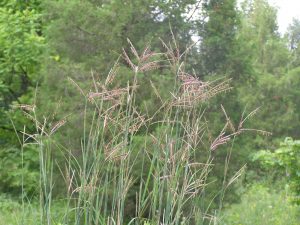
|
Big bluestem or Turkey footHeight: 2 m
Big Bluestem is a perennial, ornamental grass species that typically grows less than 2 m in height. This plant may also be known by the common name Turkey foot. The leaves are gray to bluish green in the spring, have reddish tinges in the summer, and change bronzish lavender in the fall. The flowers are purplish, three pronged resembling a turkey foot, appear in finger like clusters on tall stems, and bloom between September and February. Big Bluestem is easy to grow and is low maintenance. This plant spreads well and can form small colonies. The roots can useful for controlling erosion and stabilizing shorelines. The seeds are also beneficial to wildlife species, like birds and small mammals.
|
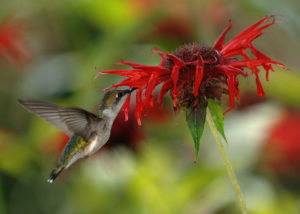
|
Oswego Tea (Red Bergamot)Height: 50 cm
Oswego Tea is a showy perennial wildflower species that typically grows about 50 cm in height. This plant may also be known by the common names Red Bergamot or Scarlet Beebalm. The leaves are dark green, oval shaped, have a minty fragrance. The unique flowers are bright red and grow in dense rounded clusters, with individual tubular flowers that bloom between May and October. The beautiful flowers of Oswego Tea attract various pollinator species like hummingbirds, butterflies, and bees. The Oswego Tea plant is susceptible to a common fungal disease, called powdery mildew, when planted in dry soils. Historically, the leaves of the plant have been used for antiseptic purposes, as well as poultices to heal minor wounds and skin infections.
|
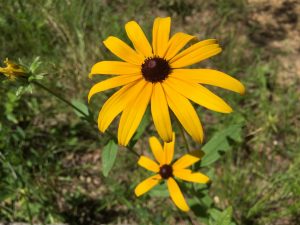
|
Black-Eyed SusanHeight: 1 m
Black-Eyed Susan is a popular biennial or a short-lived perennial wildflower species that typically grows about 1 m in height. Its leaves are green, alternately arranged, lance shaped, and covered with bristly hairs giving the leaf a grey/green colour. The flowers are daisy-like, have 8-20 yellow ray florets surrounding numerous dark brown disk florets, and blooms between June and September. The flowers are beneficial to pollinator species, like bees and butterflies. The seeds are also beneficial to wildlife species, like birds and small mammals. This flower blooms for long periods.
|
Compartment A
Naturalization Area
Top soil and cedar bark mulch have been added to prepare the site for planting. pH: acidic
pH: acidic Depth: potted
Depth: potted-
 Moisture: dry
Moisture: dry -
 Soil Type: sandy
Soil Type: sandy -
 Light conditions: full sun, shade
Light conditions: full sun, shade
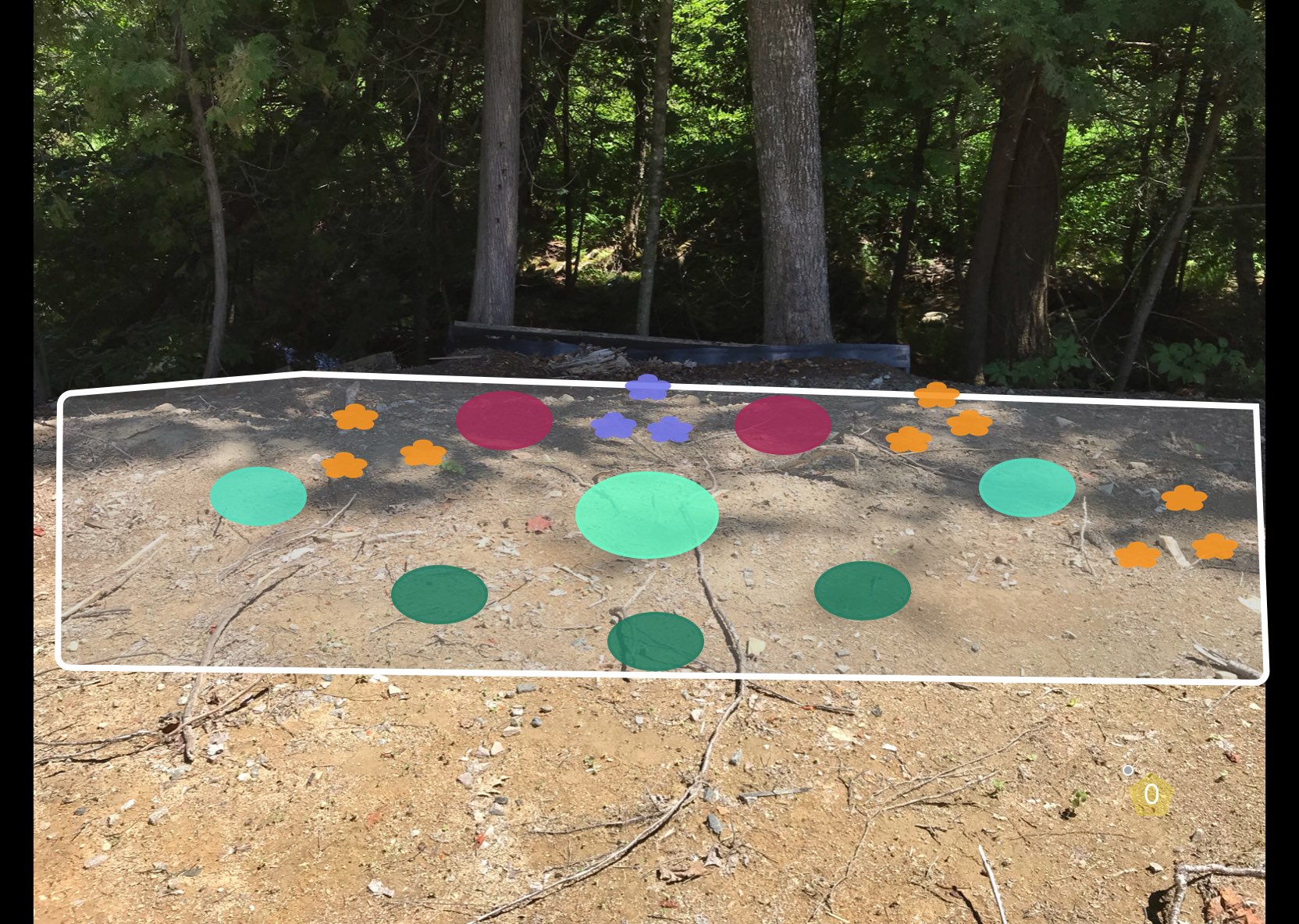
Compartment B
Naturalization Area
 pH: acidic
pH: acidic Depth: potted
Depth: potted-
 Moisture: normal, moist
Moisture: normal, moist -
 Soil Type: sandy, loamy
Soil Type: sandy, loamy -
 Light conditions: partial sun, shade
Light conditions: partial sun, shade
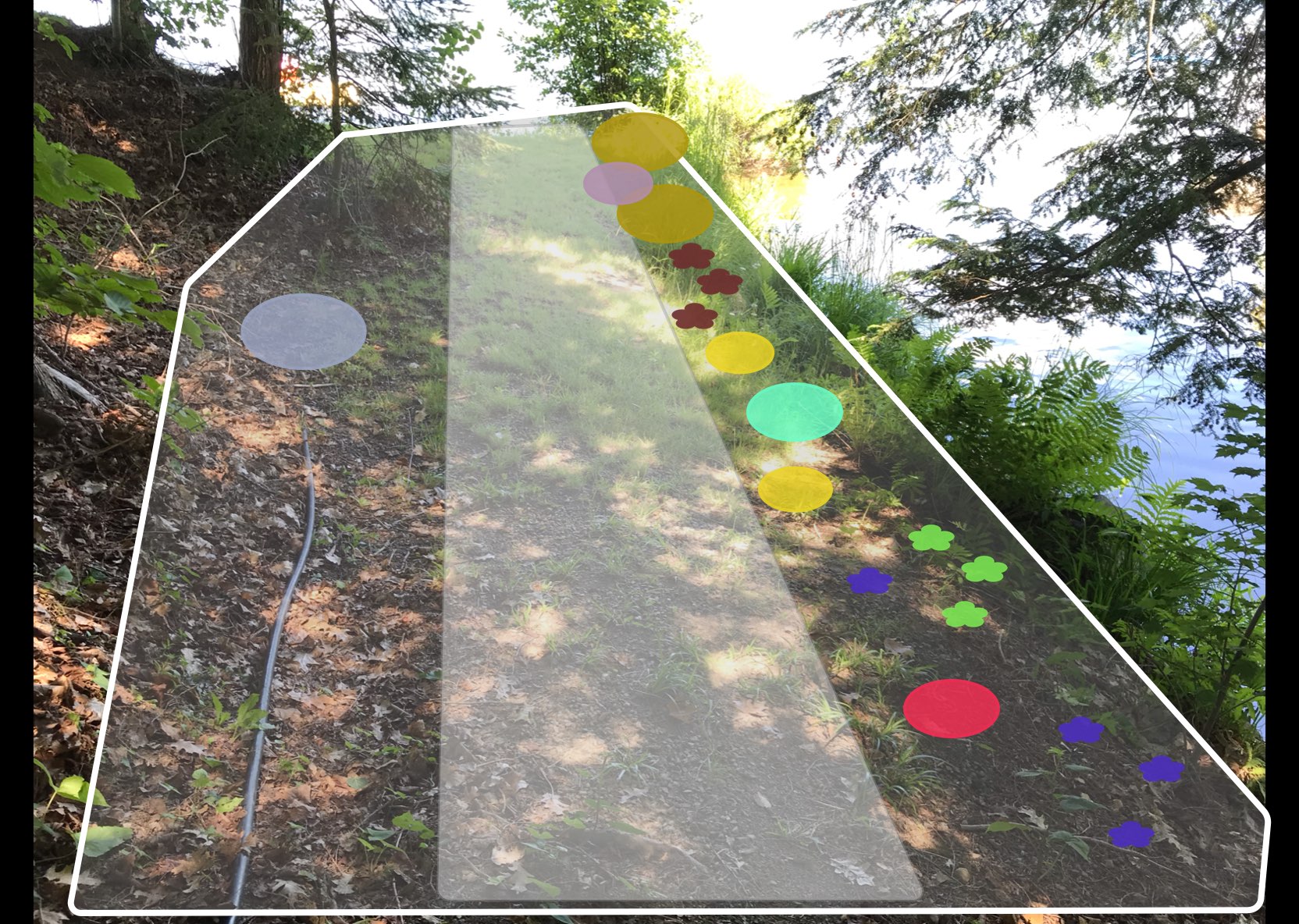
Compartment C
Naturalization Area
Top soil has been added to cover exposed tree roots. Cedar bark mulch has been added on the hill to prevent erosion. pH: acidic
pH: acidic Depth: potted
Depth: potted-
 Moisture: normal
Moisture: normal -
 Soil Type: sandy
Soil Type: sandy -
 Light conditions: shade
Light conditions: shade
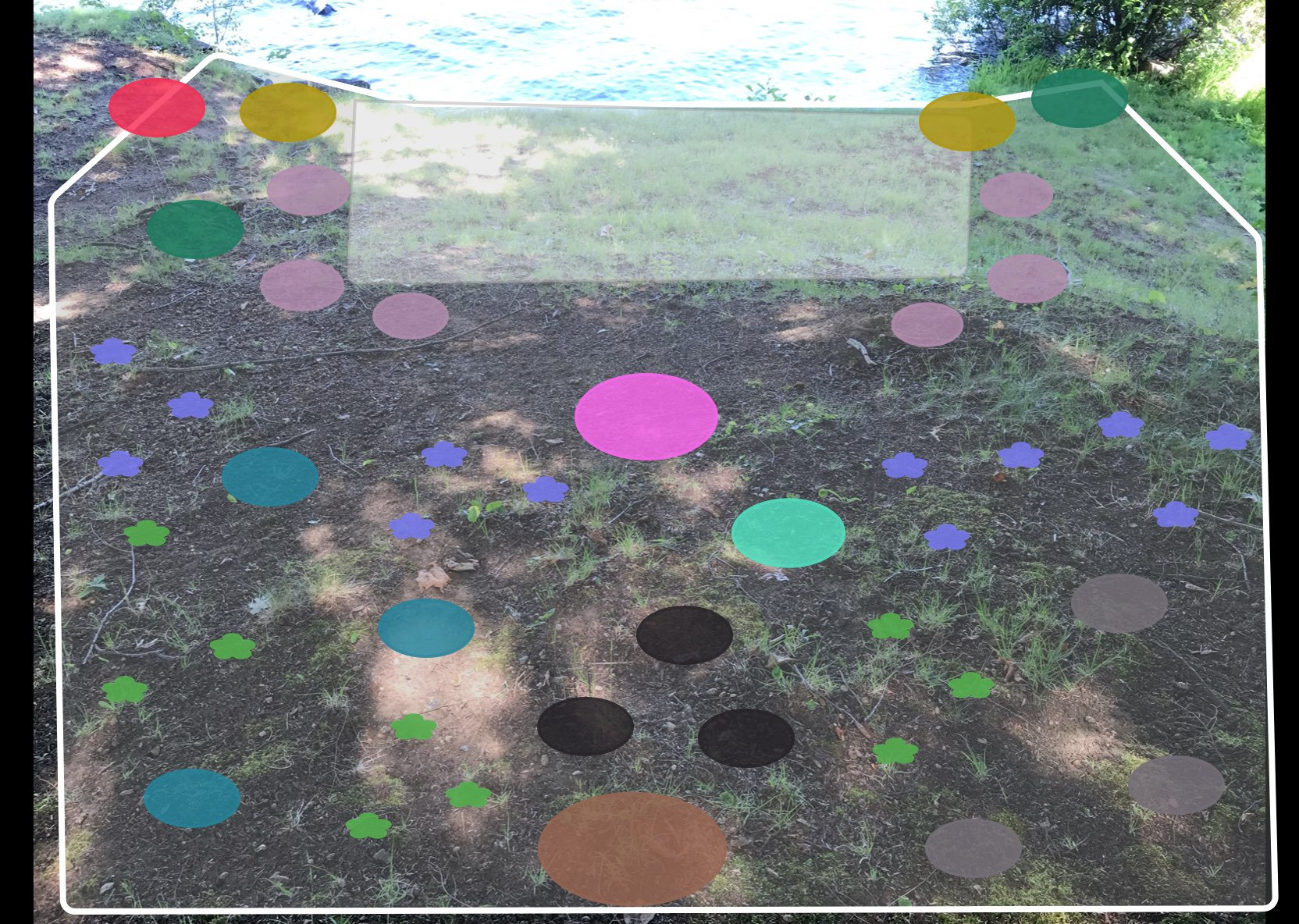
Compartment D
Naturalization Area
 pH: acidic
pH: acidic Depth: potted
Depth: potted-
 Moisture: normal
Moisture: normal -
 Soil Type: sandy
Soil Type: sandy -
 Light conditions: shade
Light conditions: shade
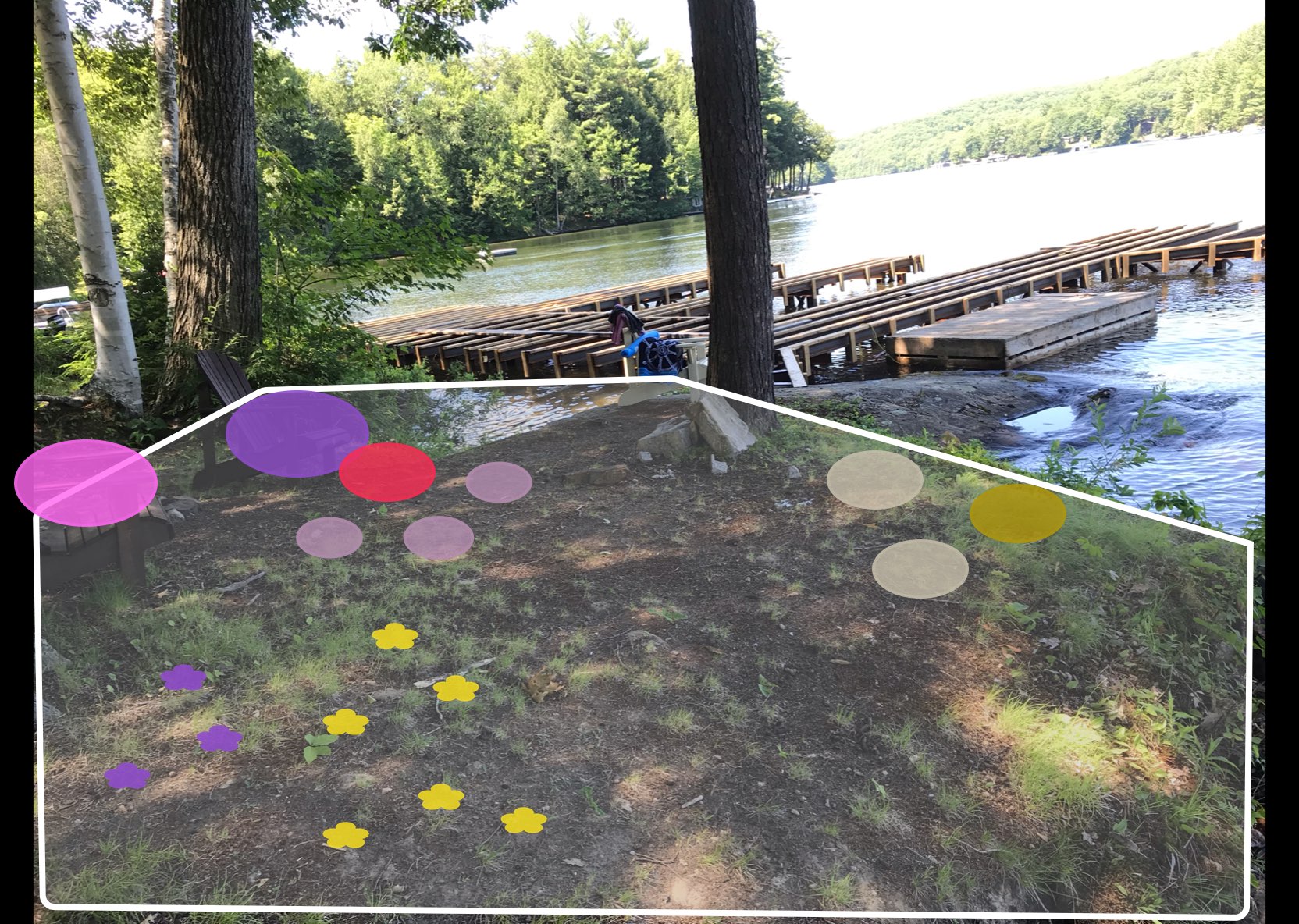
Compartment E
Naturalization Area
Top soil has been added to cover exposed tree roots. Cedar bark mulch has been added on the hill to prevent erosion. pH: acidic
pH: acidic Depth: potted
Depth: potted-
 Moisture: normal
Moisture: normal -
 Soil Type: sandy
Soil Type: sandy -
 Light conditions: shade
Light conditions: shade
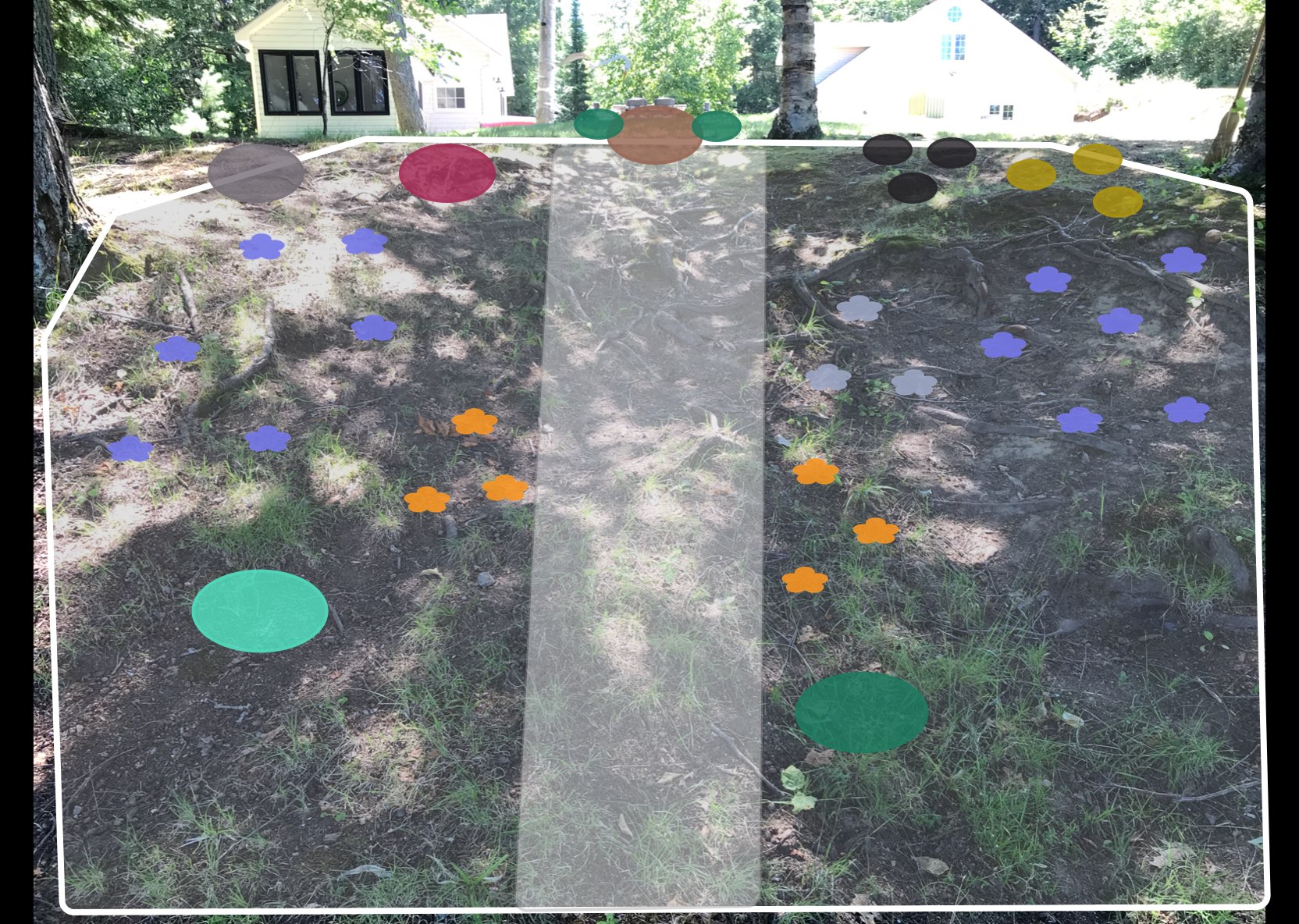
Compartment F
Naturalization Area
Top soil has been added to cover exposed tree roots. Cedar bark mulch has been added on the hill to prevent erosion. pH: acidic
pH: acidic Depth: potted
Depth: potted-
 Moisture: dry, normal
Moisture: dry, normal -
 Soil Type: sandy
Soil Type: sandy -
 Light conditions: full sun, partial sun
Light conditions: full sun, partial sun
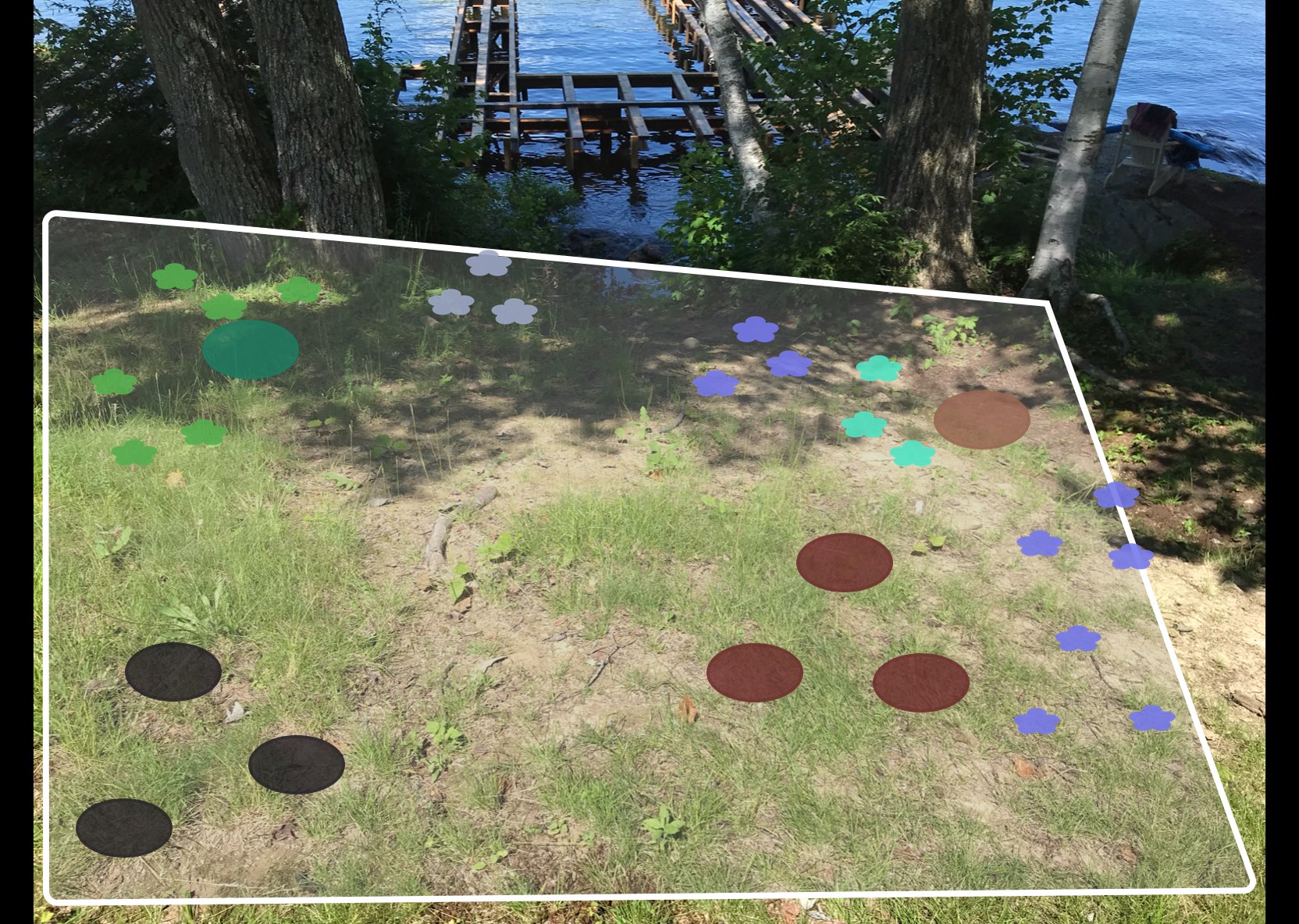
Compartment G
Naturalization Area
Steps will be removed. pH: acidic
pH: acidic Depth: potted
Depth: potted-
 Moisture: normal
Moisture: normal -
 Soil Type: sandy
Soil Type: sandy -
 Light conditions: full sun, partial sun
Light conditions: full sun, partial sun
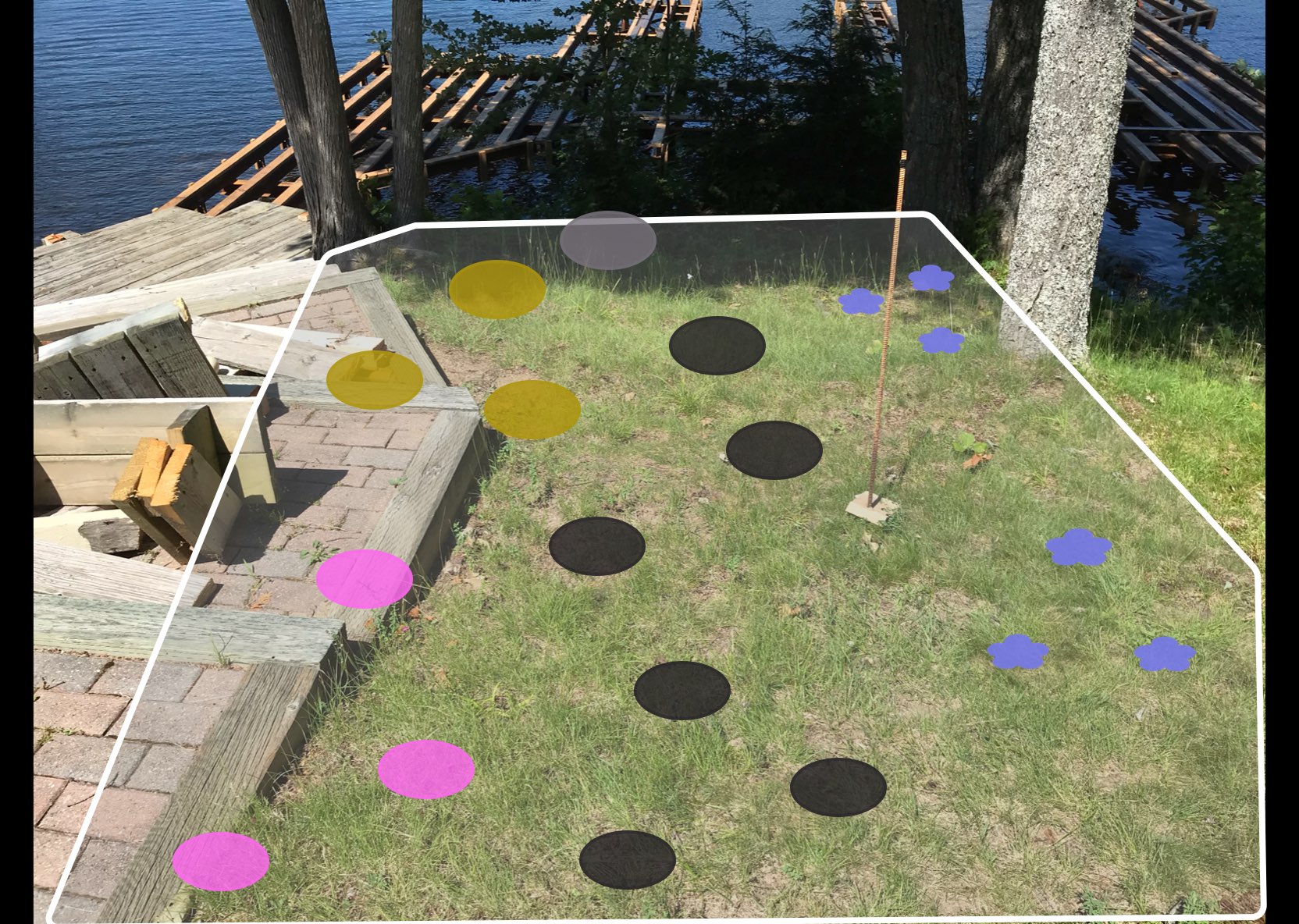
Compartment H
Naturalization Area
Tiered garden with a mixture of native species (ferns, Virginia creeper, juniper, red oak and birch) and horticultural varieties (spirea, hostas, lily, hydrangea, purple sand cherry). Recommend planting native species among existing vegetation. pH: acidic
pH: acidic Depth: potted
Depth: potted-
 Moisture: dry, normal
Moisture: dry, normal -
 Soil Type: sandy
Soil Type: sandy -
 Light conditions: full sun
Light conditions: full sun
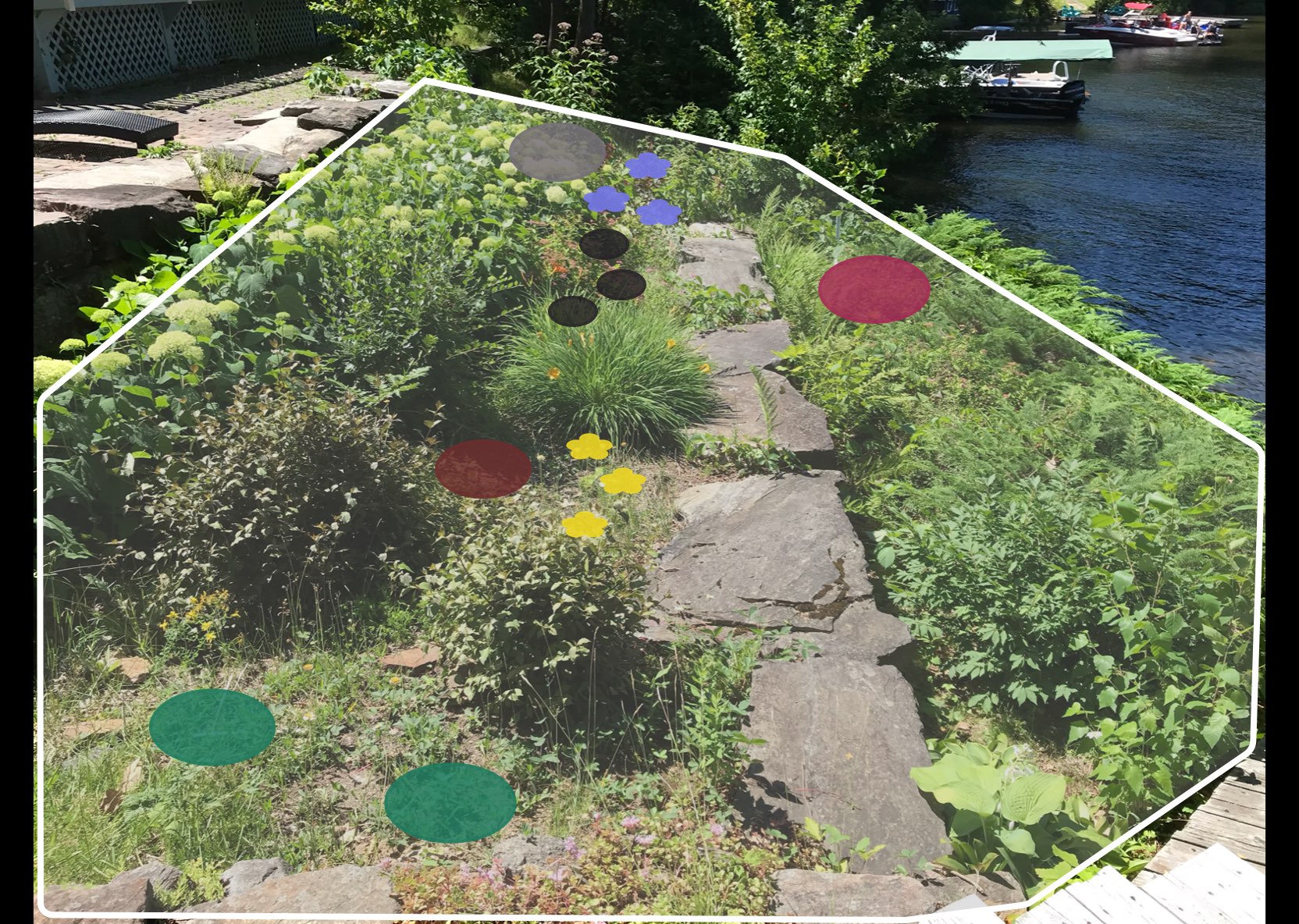
Compartment I
Naturalization Area
 pH: acidic
pH: acidic Depth: potted
Depth: potted-
 Moisture: dry
Moisture: dry -
 Soil Type: sandy
Soil Type: sandy -
 Light conditions: full sun
Light conditions: full sun
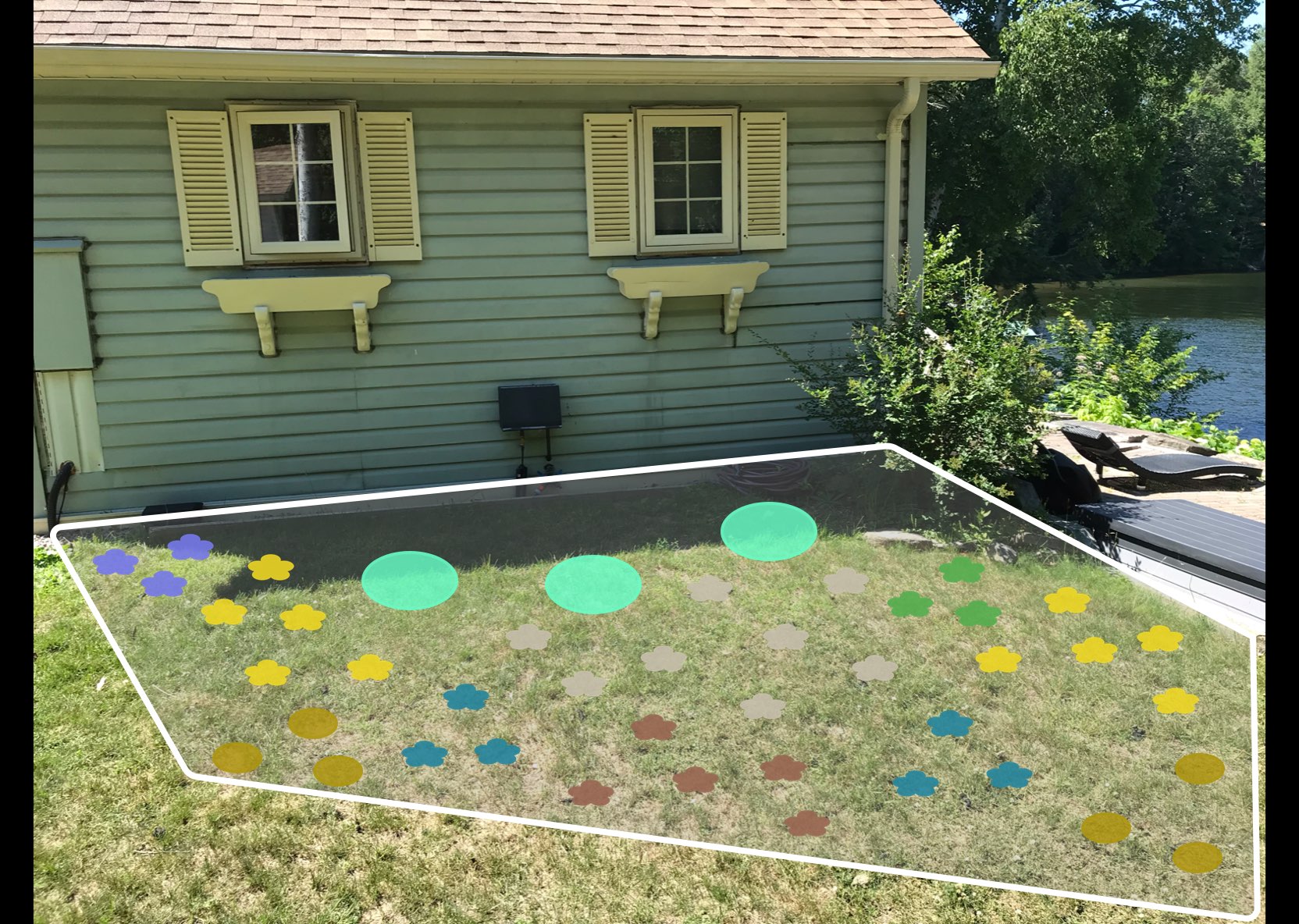
Schedule B
Financial Summary
Project by: The District Municipality of Muskoka
Shoreline Re-Naturalization Starter Kit includes: free site visit, customized re-naturalization planting plan for your shoreline property, native plants including free bare root (small) and potted (large) plants and wildflowers, coconut fibre pads to deter grass from growing around new plantings, tree guards for all deciduous trees, mulch for your wildflowers, Plant Care Guide with instructions on how to take care of your new plants, Habitat Creation Guide and a Wildflower Garden Guide.
Our planting plans are created onsite with you and provide detailed information and plans to re-naturalize your shoreline property. We take photos of areas for planting and overlay native plants that are well suited to your property based on site conditions such as soil type and sunlight availability.
We will work with you to create a plan that works for you including options for low growing plants in areas where views are important.
| Item | Quantity | Cost/Item | Subtotal |
|---|---|---|---|
| Starter Kit fee | $300 | ||
| Free potted plants | 20 | $0 | $0 |
| Paid potted plants | 79 | 12.00 | 948.00 |
| Free bareroot plants | 0 | $0 | $0 |
| Free wildflowers | 30 | $0 | $0 |
| Paid wildflowers | 111 | 6.00 | 666.00 |
| Total costs | 1914.00 |
Schedule C
Project Agreement
Stewardship Agreement
Please indicate your agreement to this proposed plan by signing the following Stewardship Agreement and submitting it, along with your financial contribution, to:
The District Municipality of Muskoka
70 Pine Street
Bracebridge, Ontario
P1L 1N3
Plant Availability
Please note that plant species may need to be changed based on plant stock availability at the time of ordering.
Project Completion
Upon receiving your signed stewardship agreement and financial contribution, a date will be booked for you to pick up your Natural Edge Kit. The District Municipality of Muskoka will supply all plants and materials. If you are paying for the planting to be completed for you, a date will be arranged for The District Municipality of Muskoka to plant your shoreline, bringing the plants and materials with them. If there are particular dates that you would prefer, we will do our best to accommodate your requests.
The Natural Edge Stewardship Agreement with The District Municipality of Muskoka
Agreement made this 17th Day of the Month of September in the Year 2020.
BETWEEN Neal Christopher 1073 The Narrows Road Ontario (Hereinafter called the OWNERS)
AND The District Municipality of Muskoka 70 Pine Street Bracebridge, Ontario P1L 1N3 (Hereinafter called DMM)
WHEREAS the Owners and DMM have met and discussed plans for shoreline naturalization on the specified area(s) in Schedule A existing on the Owners’ land;
WHEREAS the Owners indicate approval of the project as proposed; and
WHEREAS the project is, or will be for the benefit of the Owners and others;
NOW THEREFORE THE PARTIES AGREE AS FOLLOWS:
1. This Agreement shall be in effect for a period of 5 years, commencing with the date of this Agreement.
2. The Owners and DMM agree that the areas where the work is to be performed is as described in Schedule A.
3. The Owners agree to pick up their Natural Edge Starter Kit from DMM’s office and plant their shoreline within two days of receipt. The Owners will provide “after” photos of the work completed to be used for reporting purposes. If the Owners wish to have the planting completed for them, then DMM or it’s contractors, employees and agents will complete the planting at cost, as indicated in Schedule B.
4. If the planting is to be completed by DMM, then the Owners grant DMM, its contractors, employees and agents, the right to enter the property to perform the work agreed upon as outlined in Schedule A. In addition, DMM, its contractors, employees and agents may inspect the work performed for the purposes of monitoring the project and survival assessment, with prior agreement with Owners for date and time of inspection.
5. The Owners agree to contribute the “Landowner contribution” and pay the costs indicated in Schedule B.
6. In instances where the Owners are to pay DMM for work to be performed (outlined in Schedule A), the Owners agree to provide payments to DMM prior to the commencement of that operation. Failure of payment shall constitute a breach of this Agreement and the Owners agree that this Agreement will be terminated and thereupon the Owners agree to pay DMM the estimated costs of the operations of the project completed to date, if any.
7. The Owners agree, if necessary, to perform a reasonable amount of maintenance, which is described in the Native Plant Care Guide, available at naturaledge.watersheds.ca.
8. If a contractor is required to perform the work outlined in Schedule A, then the contractor carrying out the work on the land described will be required to take out and furnish evidence of a comprehensive policy of public liability and property damage coverage. The contractor and their workers will be required to be in good standing with the Workplace Safety and Insurance Board (WSIB) prior to performing the work.
9. The Owners agree not to remove, destroy or alter the project without prior consultation and approval of DMM. Pruning and trimming planted nursery stock, or adding replacement native nursery stock is exempt.
10. The Owners agree not to mow the planted area.
11. The Owners do acknowledge that DMM, its contractors, employees and agents, having performed said works, are not under further obligation with respect to survival of nursery stock, inspection, or maintenance.
12. The Owners, in the absence of negligence, hereby remise, release and forever discharge DMM, its contractors, employees and agents from all claims and demands for injuries, including death, loss, damages and costs in any way related to or connected with installation and maintenance of the work described or resulting from any deleterious effects of the work to the land or to the lands and buildings thereon retained by the Owners.
IN WITNESS WHEREOF the parties have agreed to the contents of this plan; SIGNED:
About this program
About The District Municipality of Muskoka
The District of Muskoka is an upper-tier municipality that has monitored water quality in Muskoka area lakes since 1980. Since 2002, the Muskoka Water Strategy has provided integrated and strategic initiatives for the protection of Muskoka's water resources. The purpose of the strategy is to guide and minimize the impact of human activities on water resources; ensure human and environmental health; and preserve the quality of life in Muskoka.
This program was created by Watersheds Canada
We believe that every person has the right to access clean and healthy lakes and rivers in Canada. At Watersheds Canada, we work to keep these precious places naturally clean and healthy for people and wildlife to continue using for years to come. We love working with others to meet the needs of local communities, whether you’re a concerned citizen, a landowner, a lake association looking for help, or a coalition of groups interested in activating your local community.

